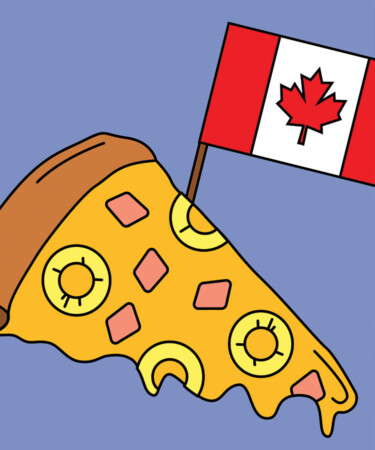This article is part of our Cocktail Chatter series, where we dive into the wild, weird, and wondrous corners of history to share over a cocktail and impress your friends.
When we think of some of our favorite foods, many are a product of culinary fusion. Consider the Vietnamese-French crossroads that is the bánh mì, the intersection of Italian and Filipino ingredients in sweet spaghetti, or literally any Tex-Mex fare. These dishes are often the product of imperialism, colonization, or plain geographic proximity between two cultures. But then there are the blended meals that are the result of kitchen sink experimentation by the hands of someone with no ties — culturally or geographically — to either food’s homeland. For all intents and purposes, we’ll call it faux fusion. Here, we’ll be talking about one of the most equally beloved and bemoaned faux-fusion dishes of all time: Hawaiian pizza.
Toasted Beginnings
Some claim that the first prototype of Hawaiian pizza was Toast Hawaii, a slice of toast topped with ham, melted cheese, a pineapple ring, and a maraschino cherry. The open-faced sandwich was first introduced by German TV chef Clemens Wilmenrod in 1955, and the Toast Hawaii never took off outside of its native Germany.
Just a couple years later, though, a similar creation popped up stateside. In 1957, Francine’s Pizza Jungle opened up shop in Portland, Ore., with the slogan “1st in Pizzas from Around the World.” The menu featured a list of variations that took some liberties with other cultures’ cuisines: There was a French Pizza topped with smoked frog legs, fried onions, and mushrooms. There was an Irish Pizza with corned beef, cabbage, and spuds. And then there was the Hawaiian Pizza, which featured pineapple, papaya, and chopped green pepper. Francine’s allegedly went out of business in less than a year, but the idea wouldn’t completely disappear.
The Pineapple Spreads
Enter Sotirios Panopoulos, a Greek native who emigrated to Nova Scotia in 1954 at age 20. Shortly thereafter, he moved to Ontario where he and his two brothers Elias and Nikitas opened the Satellite Restaurant, which offered a mix of standard American fare like burgers and fries as well as Chinese-American dishes. Outside of the restaurant, Panopoulos was an avid pizza fan. He told Food Network Canada in 2016 that, at the time, he made routine trips to Detroit to get his fix of the stuff. Given that Panopoulos and his restaurant were located so far away from Portland, it’s likely that he never got a taste of the more obscure pizzas coming out of Francine’s kitchen, but he would go on to be a pineapple and pizza advocate in his own right.
By the beginning of the ‘60s, Panopoulos had purchased a small oven, taught himself how to make pizza, and put it on the Satellite menu. And one day in 1962, he hatched the idea to put canned pineapple on it, inspired by the sweet and sour flavor combinations being made at Satellite. He continued experimenting away, eventually tossing ham and bacon into the mix.
“I shared it with some customers and they liked it,” Panopoulos told Food Network Canada. “For a long time, we were the only ones serving it.”
The Pineapple Boom
Over the following decades, Hawaiian pizza slowly became a staple at pizzerias around the globe. In 2018 alone, international pizza chain Domino’s reported that roughly 5.7 million Hawaiian pizzas were ordered in Australia, ranking it among the top four most popular types of pizza at the nation’s Domino’s. In 2016, American market research and analytics company The Harris Poll surveyed 2,193 U.S. adults in regard to their least favorite pizza toppings, and pineapple made it in the top three behind anchovies and mushrooms. And the following year, Iceland’s president, Guðni Thorlacius Jóhannesson, jokingly told a group of high school students during a Q&A session that he would ban pineapple as a pizza topping if he could.
Regardless of how sacrilegious one might find Hawaiian pizza, since its 1962 inception we’ve seen everything from barbecue chicken pizza and smoked salmon pizza to even dessert pizza enter the culinary zeitgeist. It might rile up some nonnas, but we’ll say it: Pizza has basically evolved into a template as open to interpretation as the sandwich. In some ways, Hawaiian pizza was the first domino to fall in the unconventional pizza revolution, and the world is only a better, more inclusive place because of it. So, to all the purists out there: Put mustard on watermelon, dip fries in a McFlurry, put pineapple and ham on pizza, and never yuck another’s yum.
*Image retrieved from fahrwasser via stock.adobe.com
